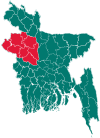Atrai Upazila
 From Wikipedia the free encyclopedia
From Wikipedia the free encyclopedia
Atrai আত্রাই | |
|---|---|
 Rabindra Katchibari at Patisar | |
 | |
| Coordinates: 24°36.8′N 88°58.2′E / 24.6133°N 88.9700°E | |
| Country | |
| Division | Rajshahi |
| District | Naogaon |
| Government | |
| • Upazila Chairman | Ibadur Rahman Pramanik |
| • MP (Naogaon-6) | Anwar Hossain Helal |
| Area | |
| • Total | 284.40 km2 (109.81 sq mi) |
| Population (2011) | |
| • Total | 193,256 |
| • Density | 680/km2 (1,800/sq mi) |
| Time zone | UTC+6 (BST) |
| Website | Official website (in Bengali) |
Atrai (Bengali: আত্রাই) is the southernmost upazila of Naogaon District, located in Bangladesh's Rajshahi Division. It is named after its principal watercourse, the Atrai River.[1]
Geography[edit]

Atrai has 45,465 households and total area 284.40 km2. Along with the Atrai River, the Nagor River, Pakar Beel, Chander Beel, Kaklaban Beel are notable water bodies.
The upazila is bounded by Raninagar and Manda upazilas on the north, Natore sadar upazila on the south, Singra upazila on the east, Bagmara upazila on the west.[1]
History[edit]

It is said that Islam Khan I, a Mughal Subahdar of Bengal, passed through Atrai (hence many villages have names such as Islampur and Islamganthi) and constructed a mosque known as the Islamganthi Mosque in the seventeenth century. Atrai later came under the zamindari of the Mollah political family.[2]
In 1916, Atrai was officially established as a thana. In 1968, the Mollah Azad Memorial College was founded in Atrai. During the Bangladesh Liberation War of 1971, a brawl emerged between the two factions in Bandaikhara on 19 September. Another encounter took place near Ghaulya and Taranagar. In a surprise attack, nine Pakistan Army ships were sunk. Its status was upgraded to upazila (sub-district) in August 1983 as part of the President of Bangladesh Hussain Muhammad Ershad's decentralisation programme.[1]
Demographics[edit]
According to the 2011 Bangladesh census, Atrai Upazila had 45,465 households and a population of 193,256. 38,390 (19.86%) were under 10 years of age. Atrai had a literacy rate (age 7 and over) of 45.38%, compared to the national average of 51.8%, and a sex ratio of 1010 females per 1000 males. 13,202 (6.83%) lived in urban areas.[3][4]
As of the 1991 Bangladesh census, Atrai has a population of 166978. Males constitute 50.88% of the population, and females 49.12%. The population above the age of eighteen years is 83466.
Administration[edit]

Atrai Upazila is divided into eight union parishads: Ashanganj, Bhonpara, Bisha, Hatkalupara, Kalikapur, Maniari, Panchupur, and Sahagola. The union parishads are subdivided into 155 mauzas and 200 villages.[3]
Atrai Thana was formed in 1916 and it was turned into an upazila on 1 August 1983.[5]
Chairmen[edit]
| Name | Notes |
|---|---|
| Bithindra Nath Saha | |
| Ohidur Rahman | |
| Muhammad Ibadur Rahman Pramanik | Present |
Facilities[edit]

Atrai Upazila has hundreds of mosques. Many of the mosques are notable tourist attractions in Atrai due to their antiquity or architectural style. These include the Islamganthi Mosque, Mahadighi Mosque, Qazipara Mosque and Mirpur Mosque.[1] The mazar (mausoleum) of Naib Ali the Dervish is situated in Sannyasbari.[6]
The upazila is home to other facilities such as the Madinatul Uloom Madrasa and Lillah Boarding Orphanage in Biharipur and the Bandaikhara Madhyapara Islamia Hafizia Madrasa and Orphanage Lillah Boarding.
Notable people[edit]
- Ohidur Rahman, politician
- Rabindranath Tagore, poet and Nobel laureate who had lived here
See also[edit]
References[edit]
- ^ a b c d Muhammad Muklesur Rahman (2012). "Atrai Upazila". In Sirajul Islam; Miah, Sajahan; Khanam, Mahfuza; Ahmed, Sabbir (eds.). Banglapedia: the National Encyclopedia of Bangladesh (Online ed.). Dhaka, Bangladesh: Banglapedia Trust, Asiatic Society of Bangladesh. ISBN 984-32-0576-6. OCLC 52727562. OL 30677644M. Retrieved 21 April 2024.
- ^ Taru, Mazharul Islam (2012). "Molla, Ahsan Ullah". In Sirajul Islam; Miah, Sajahan; Khanam, Mahfuza; Ahmed, Sabbir (eds.). Banglapedia: the National Encyclopedia of Bangladesh (Online ed.). Dhaka, Bangladesh: Banglapedia Trust, Asiatic Society of Bangladesh. ISBN 984-32-0576-6. OCLC 52727562. OL 30677644M. Retrieved 21 April 2024.
- ^ a b c "Bangladesh Population and Housing Census 2011 Zila Report – Naogaon" (PDF). bbs.gov.bd. Bangladesh Bureau of Statistics.
- ^ "Community Tables: Naogaon district" (PDF). bbs.gov.bd. Bangladesh Bureau of Statistics. 2011.
- ^ "Atrai Upazila - Banglapedia". en.banglapedia.org. Retrieved 2023-02-23.
- ^ "মাজার". Atrai Upajela (in Bengali).
